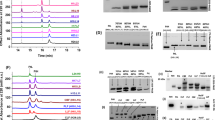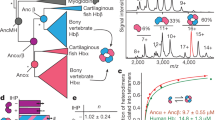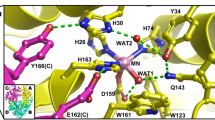Abstract
HETEROMERIC or ‘hybrid’ isozymes can be readily demonstrated by electrophoretic techniques. They can be observed, for example, in individuals who are heterozygous for alternative alleles at an autosomal locus determining a multimeric enzyme or where multiple loci are involved in the determination of a multimeric enzyme. Heteromeric forms can also be generated by techniques such as somatic cell fusion, and by dissociation and recombination in vitro. The number of heteromeric isozymes displayed by a particular enzyme is related to its subunit composition. For example, in a heterozygote a dimeric enzyme exhibits one heteromeric isozyme and two homomeric isozymes, whereas a tetrameric enzyme displays three heteromeric isozymes in addition to the two homomeric forms. Thus, the number of heteromeric isozymes provides a valuable method of assessing the number of subunits making up active enzyme molecules and indeed this approach has recently been used in a survey of the subunit structures of 66 different human enzymes1. It was found that heteromeric isozymes usually occur as described here, but there are occasional exceptions where the expected ‘hybrid’ isozymes are unusually weak or absent. We have investigated one component of the electrophoretic separation system—that is, temperature—and its influence on the occurrence of heteromeric isozymes using soluble superoxide dismutase (SODS) as a test case. This was prompted by a report that this dimeric enzyme is readily dissociated at high temperatures2; also, the heteromeric isozymes of SODS can be conveniently studied by electrophoretic methods. Our results suggest that temperature has a crucial effect on the occurrence of the heteromeric isozymes of this enzyme.
This is a preview of subscription content, access via your institution
Access options
Subscribe to this journal
Receive 51 print issues and online access
$199.00 per year
only $3.90 per issue
Buy this article
- Purchase on Springer Link
- Instant access to full article PDF
Prices may be subject to local taxes which are calculated during checkout
Similar content being viewed by others
References
Hopkinson, D. A., Edwards, Y. H. & Harris, H. Ann. hum. Genet. 39, 4383–4411 (1976).
Tegelström, H. Hereditas 81, 185–197 (1975).
Fridovich, I. A. Rev. Biochem. 44, 147–159 (1975).
Beckman, G. & Pakarinen, A. Hum. Hered. 23, 346–351 (1973).
McAlpine, P., Hopkinson, D. A. & Harris, H. Ann. hum. Genet. 34, 61–71 (1970).
Guidotti, G., Konigsberg, W. & Craig, L. C. Proc. natn. Acad. Sci. U.S.A. 50, 774–782 (1963).
Benesch, R., Benesch, R. E. & Tyuma, I. Proc. natn. Acad. Sci. U.S.A. 56, 1268–1274 (1966).
Bernstein, S. C. & Bowman, J. E. Biochim. biophys. Acta 427, 512–519 (1976).
Blume, K. G. & Beutler, E. J. biol. Chem. 246, 6507–6510 (1973).
Elsevier, S. M. et al. Nature 251, 633–635 (1974).
Pearce, J., Edwards, Y. H. & Harris, H. Ann. hum. Genet. 39, 263–276 (1976).
Gartler, S. M., Liskay, R. M., Campbell, B. K., Sparkes, R. & Gant, N. Cell Differentiat. 1, 215–216 (1972).
Blanco, A. & Zinkham, W. H. Science 139, 601–602 (1963); Goldberg, E. Science 139, 602–603 (1963).
Nance, W. E., Claflin, A. & Smithies, O. Science 142, 1075–1077 (1963).
Kagamiyama, H., Sakakibara, R., Wada, H., Tanase, S. & Morino, Y. J. Biochem. 82, 291–294 (1977).
Barra, D. et al. FEBS Lett. (in the press).
Author information
Authors and Affiliations
Rights and permissions
About this article
Cite this article
EDWARDS, Y., HOPKINSON, D. & HARRIS, H. Dissociation of ‘hybrid’ isozymes on electrophoresis. Nature 271, 84–87 (1978). https://doi.org/10.1038/271084a0
Received:
Accepted:
Published:
Issue Date:
DOI: https://doi.org/10.1038/271084a0
Comments
By submitting a comment you agree to abide by our Terms and Community Guidelines. If you find something abusive or that does not comply with our terms or guidelines please flag it as inappropriate.



